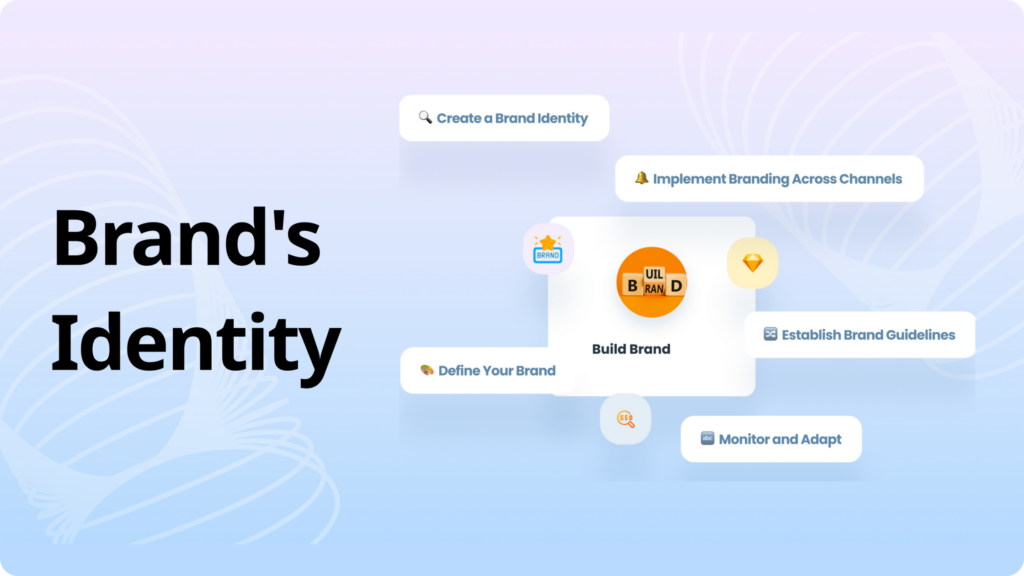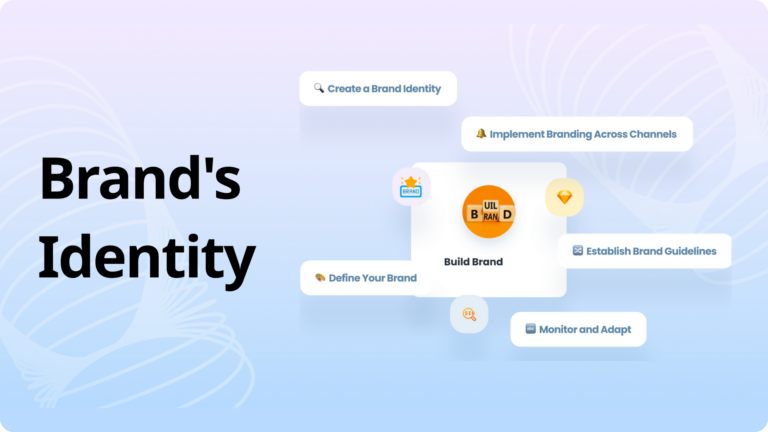Are you interested in React Native Mobile Development? This blog walks you through the fundamental ideas and functionalities of this popular framework. Find out if it is the best option for your mobile projects and how it makes creating cross-platform apps easier.
The world of mobile development has been talking about React Native for a few years now. Understandably so—by providing a means of simultaneously developing mobile applications for iOS and Android, it completely revolutionised the tech industry.
We will examine it’s definition and possibilities in this post. Having a solid understanding will enable you to decide whether or not to use it.
React Native: What is it?
A JavaScript framework called React Native which is used to create cross-platform mobile applications. Developers can write a single codebase that runs on both iOS and Android.
It was first released by Facebook (now Meta) as an open-source framework in 2015. It is one of the top two cross-platform mobile platforms alongside Flutter. There are many reasons why it has achieved notoriety. To name a few:
With cross-platform frameworks like React Native, developers can create a single app that runs on several platforms, saving time and money.
The most widely used programming language, JavaScript, is used to write React Native.
Because it leverages native UI components, people find it easy to utilise.
It reached the top of the list of mobile development solutions in a couple of years. Some of the most popular mobile applications in the world, such as Instagram, Facebook, and Skype, are powered by React Native development. In this post, we go into further detail with these and other instances of React Native-powered apps.
Oddly enough, React Native Development was created in reaction to a major technological error, just like many other ground-breaking innovations.
What is React Native Used for?
The History of React Native
Before React Native was developed, Facebook used browser technology like HTML5 to power its mobile application. Notoriety gained when Mark Zuckerberg publicly said that this was the biggest error they had ever made in 2012. The Facebook app lacked many of the appealing features of a native mobile application and was sluggish and slow.
But the solution was short-lived, with plenty of opportunity for UI and performance enhancements. In fact, Mark Zuckerberg said in 2012 that “betting too much on HTML as opposed to native” was the largest error the firm made.
In 2015, React Native was released as an open-source framework. The Android version of the React Native framework was published in September 2015. The expansion to Windows and Samsung’s Tizen operating system was announced in 2016.
It was the second-largest project on GitHub in terms of contributors after just three years of existence. It persevered and finished sixth in 2019 with more than 9,100 contributions.
Is it true that React Native apps are native?
React vs React Native
It’s possible that you’ve noticed the word “Native” in the name React Native. These applications aren’t really native, despite the fact that their appearance and user interface suggest otherwise. This is due to the fact that platform-specific languages like Swift/Objective-C and Java/Kotlin are not used in their development.
React Native, especially when using best practices and appropriate optimization, often offers a very close-to-native experience in terms of look, feel, and responsiveness, even while certain control over native features like deep system access could be limited compared to entirely native apps.
You will also come across React, which is a separate JavaScript package that serves as the foundation for React Native.
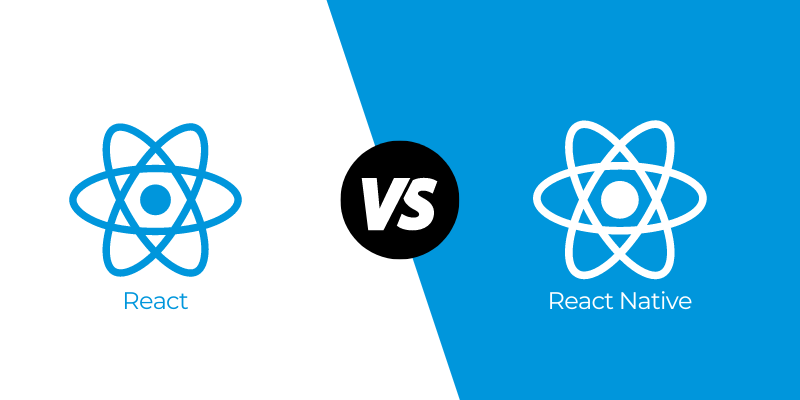
To put it simply, it utilises React, but it isn’t a “newer” version of React. Although it may seem perfect to develop an app for many platforms using a single codebase, there are a few advantages and disadvantages of using React Native instead of Native. Now let’s see how it stacks up against the Native iOS and Android development languages.
In the meanwhile, developers may easily assemble and deploy iOS and Android apps using a set of UI components thanks to React Native, which is powered by React.
React Native Features
With its wide range of pre-written libraries, React Native strikes a perfect mix between speed and performance, cutting down on both development time and effort. It makes use of strong instruments such as the Hermes JavaScript engine and effective UI rendering in order to further improve performance.
Investigating React Native is a wise choice of cost, development speed, and performance are your top priorities. Let’s examine some of it’s best features to see how it may speed up and simplify the creation of mobile apps.
Cross-platform Development
It provides first-class support for TypeScript and enables creating JavaScript apps for both the iOS and Android platforms from a single codebase. This makes it possible for developers to make even more use of TypeScript’s unique capabilities.
Vast Network of Libraries
You may develop apps more quickly and efficiently with the help of a number of features like Virtual DOM, integration with third-party libraries, and an architecture that encourages code reusability and pre-built UI components. Additionally, it enables you to create user interfaces using discrete elements known as components that may be applied to other parts of the program.
Powerful JavaScript engine
JavaScriptCore was used by React Native until 2022. As of React Native 0.70 onward, Hermes is now the standard engine for all React Native applications. Hermes provides faster JavaScript code execution, which reduces lag and improves user responsiveness when interacting with the app.
Like native applications, this JavaScript engine precompiles JavaScript code in advance into bytecode. App launches are substantially faster using this bytecode since it is simpler to execute and smaller.
Declarative Development
Declarative programming is a popular development strategy that avoids explicitly declaring how to manipulate the DOM in favour of describing the intended UI state and data flow. This indicates that React handles the intricacies of effectively rendering and updating the user interface. Developers don’t have to concentrate on the “how,” just the “what”.
React takes care of the core rendering logic, allowing you to specify how the user interface should appear based on the state and props of the component. Declarative coding simplifies your code and helps you think through how changes to the UI will affect the application.
JSX
With the help of the JavaScript syntax extension JSX, you can create structures in your code that resemble HTML. This facilitates the visualisation and writing of React components, which stand in for the user interface building pieces of your application.
Hot reloading & Live reloading
When you are debugging or making quick changes to your user interface, hot reloading is a helpful feature since it lets you make changes to your code and see them instantaneously in the preview pane.
Component-based
It makes it possible to write an application’s interface entirely out of reusable, modular parts. These elements are self-contained building blocks that are in charge of particular UI elements like buttons, lists, and navigation bars.
Support for NPM Libraries
You are not restricted to using the Core Components and APIs that come pre-installed with React Native. The npm registry contains libraries that you can locate and install.
Cost Effective
Because React Native code is cross-platform compatible, it can save a lot of money when compared to native development. You only need to write code once to deploy it on both iOS and Android when using React Native. It does away with the requirement for distinct codebases and development teams for every platform. This results in less time and effort spent on development, which directly affects cost.
Large-scale Neighbourhood
The ecosystem extends much beyond its robust features and cross-platform capabilities. What really makes it unique is the React community, which provides a wealth of opportunities for developers to interact, work together, and advance their careers.
Size of Community:
- GitHub: The React Native source has almost 2,600 contributors.
- Meetup: There are more than 150 active React Native groups worldwide.
- Discord servers: There are thousands of participants on several active React Native-focused servers.
What is development for multiple platforms?
JavaScript is used in the writing of React Native apps. The rendering system makes use of three threads.
UI thread: This thread is responsible for modifying native OS views.
Thread for JavaScript: The thread in which the developer’s code resides and React’s render phase is executed.
Background discussion thread: This topic is devoted to calculations for layout.
In React Native, a render usually happens over these three threads. The layout is drawn in the background thread, mounted in the UI thread, and the render event or trigger happens in the JavaScript thread.
Future Of React Native
This framework will see further use in the future along with a wider range of applications. Think about some of the developments that we anticipate occurring in the future.
Using a different methodology, we examine the trend in cross-platform application development and find that the market for this type of work is expected to expand at a rate of 16.7% between 2023 and 2033, reaching a valuation of USD $547 billion.
In this segment, it emerges as a frontrunner among JavaScript-based frameworks, indicating its likely expansion in the years to come.
React Native Fabric
The goal of the Meta project Fabric is to improve it’s toolchain’s compatibility with non-iOS and non-Android systems.
By cutting the number of threads from three to one, it seeks to decrease overhead and boost performance. A thread serves as a conduit for user-system communication. Significant speed increases are anticipated by streamlining the procedure.
In order to improve user experience, Fabric also claims to prioritise specific user events and deliver asynchronous rendering in React Native.
Community Support
There is a robust community. It is considerably more popular among active developers than some of its rivals, thus its future seems bright.
You might think that over time, community support will only continue to grow. It has a large user base, which makes it simpler for others to get started with the mobile app development framework. There are many GitHub pull requests for the framework.
Expanded Compatibility
The future is not clear. It’s hard to predict where technology will take us in the next ten years. New technological developments emerge every year with the potential to change our direction.
The market for watches and other wearables is now booming. Tech giants are endorsing virtual reality. Furthermore, there has already been a noticeable impact of the Internet of Things (IoT) on the worldwide market.
There will be a growing need for third-party apps that are compatible with these different devices.
With its use of Dart, a language designed by Google to be quicker than JavaScript, Google’s Flutter has eclipsed React Native in terms of adoption.
Conversely, it leverages its huge following and robust developer community. This makes easy use of a talent pool that might provide a big benefit for businesses looking for quick development and assistance.
How Does React Work ?
It works by using a bridge to translate code written in JavaScript into native components and vice versa. An essential part of translating the code into other platform languages is this bridge.
With the React Native Bridge, you can utilise native code to execute tasks like accessing device hardware and sensors, interacting with other apps, and managing intricate business logic.
Coding Framework:
You use React principles when writing JavaScript code for your application.
You can use native elements to construct bespoke UI components or use pre-built ones.
Write native Objective-C/Swift or Java/Kotlin modules for some platform-specific features.
Bridge of Communication:
The native code and JavaScript are connected by a “bridge” that enables communication between them.
The JavaScript code informs the bridge about the necessary UI modifications. The native code receives instructions from the bridge in order to render the user interface elements.
Updates and Rendering:
Native code renders the UI elements on the device by utilising platform-specific APIs. Updates to your JavaScript code are sent to the native code by the bridge, which causes a re-render. React’s “virtual DOM” effectively determines the least amount of UI changes required.
Examples of React Native Applications
Millions of applications, including those from well-known companies, are powered by React Native. For example, It is used by Meta (previously Facebook) in products like Oculus, Facebook, Messenger, and Facebook Ads Manager.
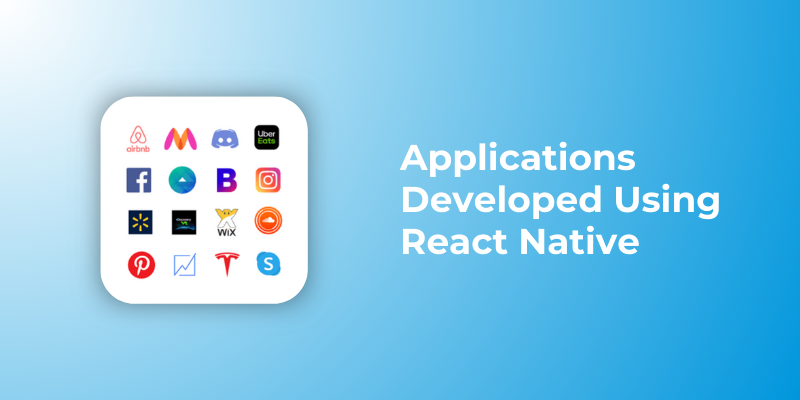
Facebook:
Since Facebook is the primary developer of this programming language and one of the more well-known React Native apps, it should come as no surprise when it is mentioned first.
Skype:
Another excellent example of a React Native mobile app is Skype. Skype declared in 2017 that it was developing a brand-new React Native app. Users were very enthusiastic regarding this because the previous version had certain problems.
Instagram:
Instagram made the decision to incorporate React Native into its already-built native application, beginning with the WebView-based Push notification user interface. Fortunately, the UI was straightforward enough to function without a navigation infrastructure, so building one wasn’t necessary. Product teams were able to increase developer velocity by 85–99% by utilising it.
Walmart:
Walmart’s iOS and Android apps are yet another intriguing example of React Native. The American supermarket chain is renowned for taking risks with technology, and one of those risks was completely redesigning its mobile apps.
A unified team oversees and develops both the Android and iOS apps, with 95% of the codebase being shared between them.
Sound Cloud Pulse:
React Native was chosen by SoundCloud Pulse SoundCloud to develop an app for musicians called SoundCloud Pulse.
They struggled to assemble a group of iOS engineers, despite their original plan to create two distinct native apps (and begin with iOS).
SoundCloud praises React Native for its quickness, improved accessibility to developers (which presented a hurdle when thinking about native mobile development), affordability, and vibrant open-source community.
Shine :
Another excellent app is Shine. Through meditation, motivational writings, and other resources, it assists its users in managing everyday stress.
Shine made its App Store debut in late 2017 and was selected by Apple as one of the greatest applications of 2018.
UberEats:
One such app that uses React Native development is UberEats. Restaurants, delivery partners, and diners are the three parties it incorporates instead of just two, which is how it varies from the Uber app.
Pinterest:
Since the framework’s release in 2015, the engineers at Pinterest acknowledge that they have been watching React Native and were curious to learn more about its potential.
They made the decision to create a prototype of the Topic Picker, a crucial onboarding element, in order to explore the potential of React Native.
Consequently, Pinterest made the decision to integrate React Native as an extra mobile development technology to its tech stack permanently.
React Native's advantages
After talking about the products created with React Native, let’s talk about the benefits of the technology and the reasons you need to use it to construct your mobile applications given below:
Cross-platform capabilities:
It offers more code reusability than native development. This is so that, unlike with native development, programs for both iOS and Android can be created using a single codebase. They are able to reuse the code for both functional systems by integrating 90% of the native framework.
Savings in time and resources:
It is cross-platform, so teams can create apps faster using it than with native programming. Additionally, businesses save money because, in most cases, developing a single app for both iOS and Android involves fewer development resources than developing native apps would.
Large-scale developer community
It is an open-source JavaScript platform that lets programmers share their expertise in the development of a publicly available framework. They can always find someone to assist them in solving their problems, which is beneficial for honing coding abilities as well.
Efficiency of Cost
Increased cost efficiency is another benefit of using React Native for development. This is due, as was previously indicated, to the fact that developers may create programs for both iOS and Android using the same code.
The cost of developing apps in React Native is much lower than apps built using languages that don’t allow for cross-platform development.
Time and resource savings
It saves teams time when developing apps because it is cross-platform, unlike native programming. Additionally, businesses save money because developing a single app for iOS and Android usually requires fewer development resources than developing native apps. Compared to apps developed with languages that prevent cross-platform development, React Native app development is far less expensive.
Basic User Interface
The app’s interface is built using React JavaScript in React Native development, which improves user experience overall by making the app faster, more responsive, and less likely to crash.
The framework’s component-based methodology and reactive graphical user interface make it ideal for creating apps with both intricate and straightforward designs.
Future Proof
With how quickly the framework gained popularity in the industry and how easily it can solve development issues, React Native appears to have a promising future for cross-platform applications. Although it has some drawbacks, which we’ll go over in the next section, its ease of use and quick development make up for them.
React Native Disadvantages
Before you choose to create a React Native app, not every mobile application is a good fit for React Native. The following are some of it’s drawbacks or weaknesses:
Absence of some customised modules:
Even though it has been available for a while, there are still certain custom modules that are either completely absent or might use some development.
This implies that you may need to maintain three different codebases instead of just one, one for iOS, Android, and React Native.
Issues with Compatibility and Debugging
Although this might surprise you—after all, many tech companies utilize React Native—it’s still in beta. Various problems with debugging tools or package compatibility may arise for your developers. Your development may suffer if your developers are not experienced in React Native since they will have to spend more time on laborious troubleshooting.
Scalability
React Native will typically function flawlessly for you even if your program later develops into a really comprehensive, complex solution.
After all, businesses like Facebook and Skype have been utilizing the framework successfully and regularly spanning many years. However, a few businesses have chosen not to use React Native after all.
Debugging
Thanks to the JavaScript community, React Native offers an excellent developer toolbox. However, because mistakes can occur in the UI thread, background thread, or JavaScript thread, debugging can occasionally be challenging.
React Native Vs Flutter
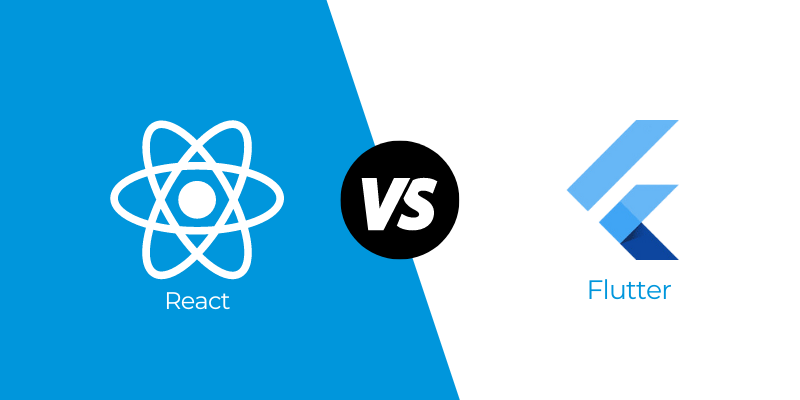
The largest competitor of React Native in terms of cross-platform development frameworks is Flutter. Google offers an open-source tool called Flutter for building cross-platform mobile applications. It is a whole software development kit, not a framework or library. The programming language Dart is used by it.
Two cross-platform frameworks, React Native and Flutter, were created by well-known software companies, Google and Facebook. Both frameworks are among the most popular ones, however developers choose Flutter over React Native.
When considering React Native to Flutter, there are a few essential variables to consider.
Source Stackover Flow
Given that Flutter is the platform of choice for programmers, you might assume that it’s the greatest choice for developing your app.
Development
Using Flutter is simple; all you have to do is download the package, unzip it, and set up an environment variable to point to the folder located inside the decompressed folder. Widgets, which are plentiful but sadly non-adaptive, comprise its system of operation. You will therefore need to manually design widgets that are specific to each platform.
Ecosystem
Regarding the ecosystem, it is superior to Flutter. With hundreds of programs supporting it, it has been around longer. Compared to Flutter, which has over 1,450 packages available, it actually has five times as many packages.
Performance
Conversely, Flutter facilitates developers’ ability to reuse pre-existing code. Because Flutter is powered by a C++ engine, it may have a tiny advantage over React Native, which employs UI components that are compiled to their native equivalents. It is also a little slower than Flutter because of the JavaScript layer.
Customer Base:
As you saw before in this piece, it boasts tens of thousands of elite tech talent on staff, from SoundCloud and Skype to Facebook, Instagram, Walmart, and more. But let’s not overlook who developed Flutter! Being a framework developed specifically for Google, it powers Alibaba, an Asian digital powerhouse, in addition to numerous Google services (like Google Ads).
Architecture
The two patterns that form the foundation of React Native‘s architecture are Redux, which was developed by its community, and Flux, which was established by Facebook. Unidirectional data flow, in which each component receives data from one location and sends changes to another, is the foundation of flux. Redux uses the same app development methodology as Flux as it employs Flux architecture. Essentially, both of these methods involve centralising your application data into a location known as a “store.
The architecture of Flutter can be approached in two ways. The initial is the Business Logic Component, or BLoC, paradigm that was first presented by Google in 2018.
Documentation
Flutter is without a doubt the champion in this area. A toolkit that aids developers during the app development process is included with the framework. Furthermore, Flutter’s documentation is regarded as being thorough and well-structured.
React Native, it should be noted, also has a vibrant community and a wealth of documentation. For first-time users, there are a ton of tutorials available. But it’s more difficult to set up than with Flutter.
Conclusion
You will gain an extensive understanding of React Native, its potential for both individuals and businesses, and its exciting future prospects by reading this article. It may be the secret to your success whether you’re searching for a cost-effective app development solution or a user experience that feels native.
As opposed to creating native apps from scratch, you may significantly reduce development costs by developing a single codebase that works with both iOS and Android.
Moreover, React Native advantages greatly from the large community of JavaScript developers. It is no longer necessary to possess specialist expertise in many native languages because of this easily accessible skill pool.
But you shouldn’t go on your mobile app adventure by yourself. Our expert React Native development services at Deliverables Agency are designed to help you at every step of the way.
FAQs
We needed React Native because it allows developers to build mobile applications using JavaScript and React, leveraging a single codebase for both iOS and Android platforms. This streamlines development, reduces time and cost, and facilitates faster iterations and updates across multiple platforms.
Some alternatives to React Native include Flutter, Xamarin, NativeScript, and Ionic. Each has its own strengths and may be better suited for certain projects depending on factors like performance requirements, developer expertise, and target platforms.
Look no further than Deliverables Agency, where we specialize in providing top-tier React Native app development services. Our team of skilled developers is equipped with the knowledge and expertise to bring your app idea to life with React Native’s powerful framework.



